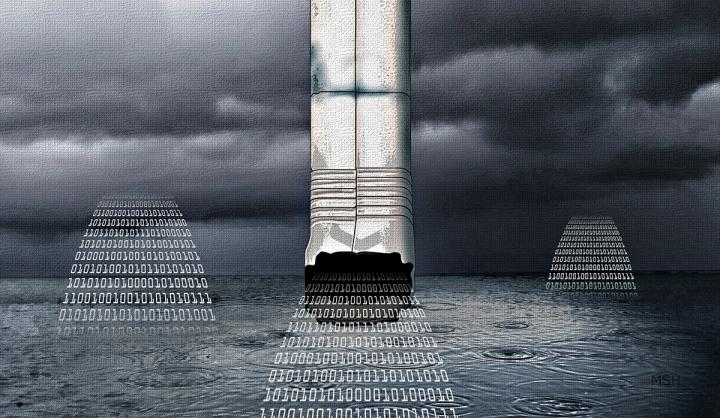Tracking the flow of quantum information

A Yale-led group of researchers has derived a formula for understanding where quantum objects land when they are transmitted. Credit Illustration by Michael S. Helfenbein/Yale University
Now a Yale-led group of researchers has derived a formula for understanding where quantum objects land when they are transmitted. It's a development that offers insight for controlling open quantum systems in a variety of situations.
“The formula we derive turns out to be very useful in operating a quantum computer,” said Victor Albert, first author of a study published in the journal Physical Review X. “Our result says that, in principle, we can engineer 'rain gutters' and 'gates' in a system to manipulate quantum objects, either after they land or during their actual flow.”
In this case, the gutters and gates represent the idea of dissipation, a process that is usually destructive to fragile quantum properties, but that can sometimes be engineered to control and protect those properties.
The principal investigator of the research is Liang Jiang, assistant professor of applied physics and physics at Yale.
It is a fundamental principle of nature that objects will move until they reach a state of minimal energy, or grounding. But in quantum systems, there can be multiple groundings because quantum systems can exist in multiple states at the same time — what is known as superposition.
That's where the gutters and gates come in. Jiang, Albert, and their colleagues used these mechanisms to formulate the probability of quantum objects landing in one spot or the other. The formula also showed there was one situation in which superposition can never be sustained: when a quantum “droplet” in superposition has landed in one “puddle” already, but hasn't yet arrived at the other “puddle.”
“In other words, such a superposition state always loses some of its quantum properties as the 'droplet' flows completely into both puddles,” Albert said. “This is in some ways a negative result, but it is a bit surprising that it always holds.”
Both aspects of the formula will be helpful in building quantum computers, Albert noted. As the research community continues to develop technological platforms capable of supporting such systems, Albert said, it will need to know “what is and isn't possible.”
###
Additional co-authors of the study are Barry Bradlyn of Princeton and Martin Fraas of KU Leuven.
Media Contact
All latest news from the category: Physics and Astronomy
This area deals with the fundamental laws and building blocks of nature and how they interact, the properties and the behavior of matter, and research into space and time and their structures.
innovations-report provides in-depth reports and articles on subjects such as astrophysics, laser technologies, nuclear, quantum, particle and solid-state physics, nanotechnologies, planetary research and findings (Mars, Venus) and developments related to the Hubble Telescope.
Newest articles

A universal framework for spatial biology
SpatialData is a freely accessible tool to unify and integrate data from different omics technologies accounting for spatial information, which can provide holistic insights into health and disease. Biological processes…

How complex biological processes arise
A $20 million grant from the U.S. National Science Foundation (NSF) will support the establishment and operation of the National Synthesis Center for Emergence in the Molecular and Cellular Sciences (NCEMS) at…

Airborne single-photon lidar system achieves high-resolution 3D imaging
Compact, low-power system opens doors for photon-efficient drone and satellite-based environmental monitoring and mapping. Researchers have developed a compact and lightweight single-photon airborne lidar system that can acquire high-resolution 3D…





















